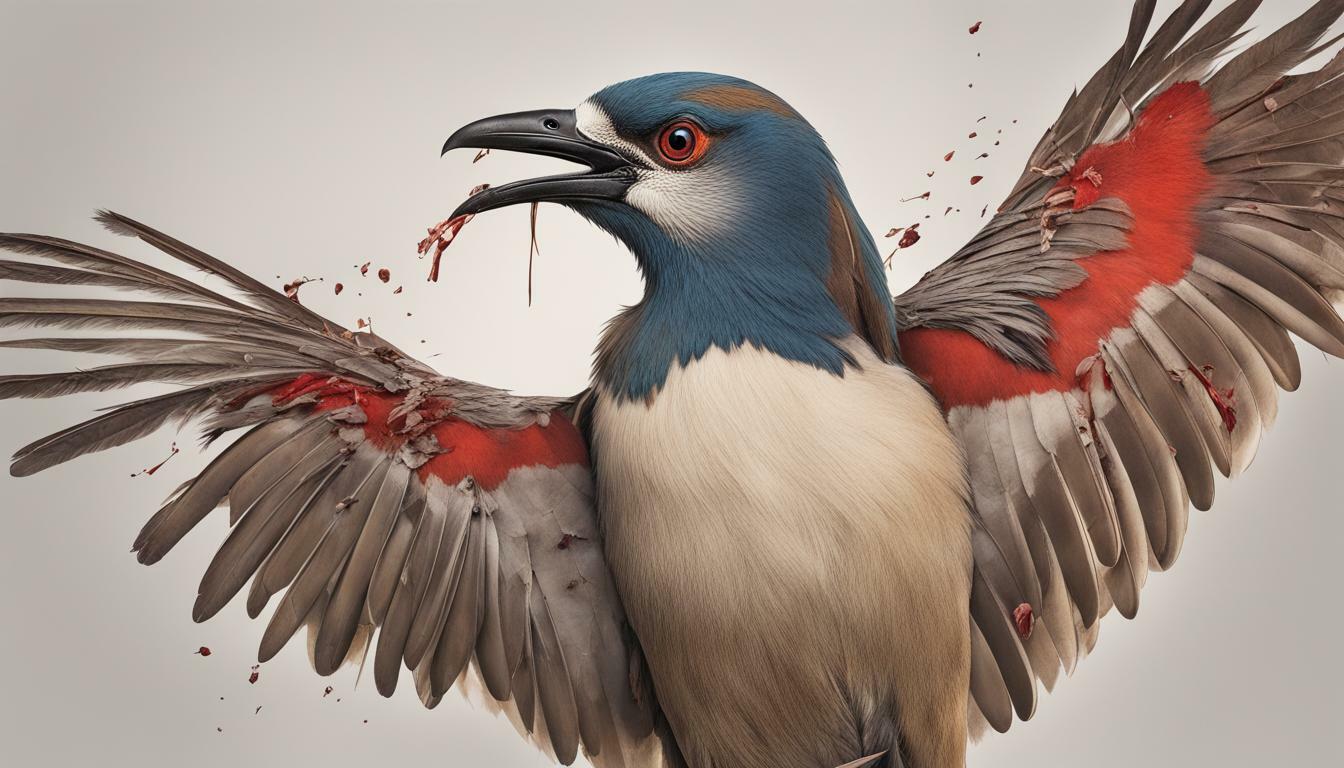As nature enthusiasts, we are often left in awe of the diversity of birds and their fascinating behavior. The avian world is complex, and understanding bird dietary habits is crucial to protecting and preserving their unique ecosystems. If you are wondering whether birds eat meat, this article will unravel the dietary facts and explore the various feeding habits of our feathered friends.
Birds have a wide range of dietary habits, ranging from herbivorous to carnivorous. Some birds primarily eat meat, while others consume a combination of meat and plant matter. Their diet is closely linked to their behavior, habitat, and evolutionary adaptations, making it an exciting area of study for bird enthusiasts and researchers alike.
Key Takeaways:
- Birds have diverse dietary habits, including carnivorous, herbivorous, and omnivorous species.
- Bird behavior, habitat, and evolutionary adaptations play a significant role in shaping their feeding habits.
- The role of meat in avian diets is essential for specific bird species, particularly in breeding and migration patterns.
- The impact of human activities, such as habitat destruction and bird feeders, can influence bird dietary habits.
Types of Bird Diets
Birds have different dietary habits depending on their species, habitat, and behavior. Understanding the types of bird diets is crucial to providing proper bird nutrition. There are two main types of bird diets: carnivorous and omnivorous.
Carnivorous Birds
Carnivorous birds are those that primarily eat meat. They have sharp beaks and talons that enable them to hunt and kill their prey. Some common examples of carnivorous birds include eagles, hawks, owls, and falcons. These birds require a high protein diet to maintain their energy levels and build strong muscles.
It is important to note that not all carnivorous birds eat only meat. Some may also consume insects, fish, and other small prey. Additionally, some birds may switch to a different diet depending on the season or availability of food.
Omnivorous Birds
Omnivorous birds are those that consume both meat and plant matter. They have a varied diet that includes insects, fruits, seeds, and small prey. Some common examples of omnivorous birds include crows, magpies, and pigeons.
Omnivorous birds require a balanced diet to maintain their health and energy levels. Proper nutrition is especially important for omnivorous birds that feed on a wide variety of foods, as they may be more susceptible to nutrient deficiencies.
Understanding the types of bird diets and their nutritional needs is crucial to ensuring the health and well-being of your feathered friends.
Meat-Eating Birds: Exploring Carnivorous Species
While many people associate birds with seeds and insects, there are actually numerous bird species that primarily eat meat. These meat-eating birds, also known as carnivorous birds, have unique hunting and feeding behaviors that set them apart from their herbivorous counterparts.
One well-known example of a meat-eating bird is the bald eagle, which predominantly feeds on fish. These birds of prey are equipped with sharp talons and beaks that allow them to catch and tear apart their prey. Another carnivorous bird is the peregrine falcon, which is known for its impressive hunting speed. These birds can dive at speeds of over 200 miles per hour to catch their prey, which includes other birds and small mammals.
There are also many lesser-known meat-eating birds, such as the burrowing owl and the roadrunner. These species primarily feed on insects and small animals, using their quick reflexes and powerful beaks to catch their prey.
It’s important to note that not all birds that eat meat are strictly carnivorous. Some bird species, such as the crow and the seagull, are opportunistic feeders that will consume both meat and plant matter. These omnivorous birds have adapted to have a wider range of dietary options, allowing them to thrive in a variety of habitats.
Omnivorous Birds: Balancing Meat and Plant Matter
While some birds are strictly carnivorous and others exclusively herbivorous, omnivorous birds have the unique ability to consume both meat and plant matter. With such a varied diet, these birds must find a balance between their carnivorous and herbivorous tendencies to ensure they are getting the proper nutrients for their overall health.
One common example of an omnivorous bird is the American Crow. These birds consume a wide variety of food, including insects, small mammals, fruits, and seeds. They use their sharp beaks and strong jaw muscles to crack open nuts and seeds, and their long, curved beaks to probe into the soil for insects.
Another example is the Northern Flicker, which primarily feeds on insects but also consumes fruits and seeds. These birds use their long, barbed tongues to extract insects from tree bark and their strong beaks to break into nuts and seeds.
It is important for omnivorous birds to have a varied diet that includes both animal and plant matter to ensure they are getting all the necessary nutrients for their health and wellbeing. This includes a balance of protein, carbohydrates, fats, minerals, and vitamins. A lack of any of these essential nutrients can lead to malnutrition and health problems.
Just like with carnivorous birds, the nutritional requirements of omnivorous birds vary depending on the species, environmental factors, and other individual needs. Therefore, it is important to provide a balanced diet when feeding omnivorous birds in captivity or through bird feeders.
Overall, omnivorous birds are fascinating creatures that possess a unique ability to balance their meat and plant matter intake. By understanding their dietary habits, we can better appreciate the diversity of bird diets and the importance of nutrition for avian health.
Understanding Bird Feeding Habits
Feeding habits are an essential aspect of a bird’s life, influencing their health, behavior, and survival. Birds have evolved a diverse range of feeding techniques and adaptations that allow them to obtain their dietary needs efficiently. Here’s a closer look at the bird feeding habits and their role in the avian diet.
Beak Shape and Foraging Strategies
Birds’ beaks have evolved to suit their specific food preferences and foraging strategies. Some birds, such as woodpeckers and finches, have beaks that can break into hard seeds, while others, like hummingbirds and nectar feeders, have long, slender beaks that can reach deep into flowers for nectar. Still, others, such as birds of prey, have sharp, curved beaks that help them tear apart their prey.
Birds use various foraging strategies to find food. Some, like ducks and swans, are filter feeders, skimming small plants and animals from the surface of the water. Others, like hawks and eagles, are aerial hunters, targeting prey from above. Many birds, such as sparrows and robins, are ground feeders, foraging for insects and seeds on the ground.
Food Availability and Seasonal Changes
Birds’ feeding habits are influenced by seasonal changes in food availability. During the breeding season, birds require high-protein diets to sustain their energy-intensive activities, such as egg-laying and chick-rearing. In winter, when food is scarce, many birds switch to seed-based diets. Migratory birds also adjust their feeding habits to suit their changing environments.
Attracting Birds to Your Yard
If you want to attract birds to your yard, offering a variety of feeders and birdhouses can help. Different bird species prefer different types of food, so offering a range of options, such as sunflower seeds, suet, and fruit, can attract a diverse array of birds. Be sure to place feeders in safe, visible areas away from predators, and keep them clean to prevent the spread of disease.
Understanding bird feeding habits is crucial to appreciating the beauty and diversity of avian life. By offering food sources and creating safe habitats, you can play an active role in supporting bird populations in your area.
The Role of Meat in Avian Diets
Meat is an important part of many bird diets, especially for meat-eating birds that require high amounts of protein and fat to sustain their energy needs. Avian diets vary widely depending on the species, but meat-eating birds, such as eagles, hawks, and owls, have evolved to thrive on a diet rich in meat.
Meat provides essential nutrients that are important for avian health and reproduction. Protein is a critical component of bird diets, as it is necessary for tissue growth and repair, and for producing enzymes and hormones. Fat is an important energy source for birds, particularly during breeding and migration. Meat is also a source of vitamins and minerals that are important for overall health.
Meat is particularly important for certain bird species that rely on it for breeding and migration. For example, Arctic terns, a migratory seabird, feed almost exclusively on small fish and invertebrates during their migration from the Arctic to the Antarctic. Without access to this high-fat, high-protein diet, they would not be able to sustain the energy required for their long-distance journeys.
It is important to note that not all bird species require meat in their diets. Many birds, such as waterfowl, songbirds, and doves, have adapted to a plant-based diet and can obtain the nutrients they need from seeds, nuts, fruits, and insects.
Overall, meat plays a crucial role in many bird diets and is essential for the health and survival of certain bird species. Understanding the role of meat in avian diets is important for ensuring the proper nutrition of birds, and for gaining a deeper appreciation of the fascinating ways in which birds have adapted to their environments.
Factors Influencing Bird Dietary Habits
Birds have diverse dietary habits that are shaped by a variety of factors. Understanding these factors can give us insight into the fascinating world of bird behavior and feeding habits.
Bird Behavior: The behavior of birds plays a crucial role in the types of food they eat. For example, birds that live near bodies of water, such as ducks and herons, primarily eat fish. Birds that forage on the ground, like sparrows and finches, mainly consume seeds and insects.
Bird Feeding Habits: Different bird species have unique feeding habits that allow them to obtain food in their specific habitats. Beak shape and size play an important role in how birds capture and consume their food. For example, finches have short, strong beaks that allow them to crack open tough seeds. Hummingbirds, on the other hand, have long, slender beaks that are perfect for sipping nectar from flowers.
The availability of food sources can also impact bird feeding habits. For example, during the winter months, when food is scarce, some bird species will migrate to areas where food is more abundant. Other species, like blue jays, will store extra food during the fall to prepare for winter.
Human Activities: Human activities can also influence bird dietary habits. The destruction of habitat due to urbanization and deforestation can impact the availability of food sources for birds. Additionally, bird feeders can attract specific bird species to certain areas, altering their natural feeding habits.
By understanding the factors that influence bird dietary habits, we can better appreciate the complexity and diversity of avian diets.
Conclusion
As you have learned, birds have a diverse range of dietary habits, with some species primarily consuming meat, while others have a more balanced diet of both meat and plant matter. Proper nutrition is essential for avian health, and their dietary habits can impact their breeding and migration patterns.
Meat-eating birds have fascinating hunting and feeding behaviors and play an important role in maintaining a healthy ecosystem. However, it is important to respect their natural behaviors and not interfere with their hunting habits.
Overall, exploring bird dietary habits can be a fascinating and rewarding experience. By understanding the factors that influence their feeding behaviors, such as habitat and evolutionary adaptations, you can gain a greater appreciation for these remarkable creatures and the role they play in our world.
Whether you are a birdwatching enthusiast or simply curious about the natural world, learning more about bird diets is a great way to deepen your understanding of these amazing creatures. So go out and explore the world of birds and their dietary habits, and discover the wonder of avian life.
FAQ
Q: Do birds eat meat?
A: Yes, some birds do eat meat. While the majority of bird species have a diet primarily consisting of seeds, fruits, and insects, there are certain bird species that are carnivorous and feed on meat.
Q: What types of diets do birds have?
A: Birds can have various types of diets. Some birds are strictly herbivorous and feed on plant matter, while others are omnivorous and consume both meat and plant matter. Additionally, there are carnivorous birds that primarily eat meat.
Q: Which bird species are meat-eating?
A: There are several bird species that are known to be meat-eaters. Examples include raptors like eagles and hawks, as well as scavengers like vultures and crows. These birds have specialized beaks and hunting techniques that allow them to capture and consume meat.
Q: How do omnivorous birds balance their diet?
A: Omnivorous birds have the ability to balance their diet by consuming both meat and plant matter. They may feed on insects, small vertebrates, fruits, seeds, and nectar, depending on their species and availability of food sources.
Q: How do birds find and consume their food?
A: Birds have various feeding techniques and adaptations that enable them to find and consume their food. This includes beak shape, foraging strategies like probing or pecking, and the ability to navigate different habitats and find food sources.
Q: What role does meat play in avian diets?
A: Meat provides important nutritional benefits to birds, such as high protein and fat content. For meat-eating birds, it is an essential part of their diet, providing energy for flight, reproduction, and migration. It also contributes to their overall health and well-being.
Q: What factors influence bird dietary habits?
A: Bird dietary habits are influenced by a variety of factors. These include bird behavior, habitat availability, evolutionary adaptations, and the impact of human activities. Changes in food availability and habitat destruction can greatly affect the dietary habits of bird populations.











